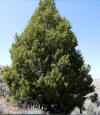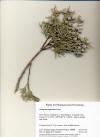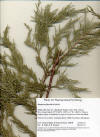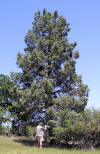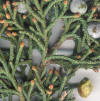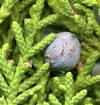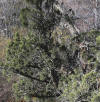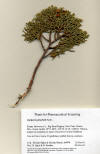|
San Luis Obispo Co. CA |
Kern River Canyon, ~2,400 ft, image of entire plants, Mar 2011, close-up, Feb 2012. SPJ-16861, dioecious, fruit (arcesthida) with 2 seeds.
|
West of Canebrake Creek crossing, Hwy 178, ~4,200 ft, image of tree-female, Mar 2011, all other Feb 2012. SPJ-16862, dioecious, fruit (arcesthida) with 1 seed.
|
|
Juniperus californica Spring Mountains, NV;
|
Juniperus californica Southern Sierra
Nevada/Tehachapi Mts.,
|
Apache-Sitgreaves Natl. For.,
northeastern AZ
|
|
Juniperus deppeana Apache-Sitgreaves Natl. For.,
AZ
|
Juniperus deppeana
Coronado National Forest, NM
|
Juniperus flaccida Chisos Mts., TX
|
|
Juniperus grandis Domeland Wilderness, Inyo. Co., Juniperus grandis Sierra Nevada, Yosemite Natl.
Park |
Juniperus occidentalis
|
Juniperus occidentalis |
  Juniperus osteosperma Southern Utah, Fish Lake Dist., Sep 2007. Monoecious.
|
Juniperus osteosperma Central Nevada, Monitor Range., July 2007
|
Juniperus osteosperma Spring Mts., Lovell Canyon, ~4,700 ft, NV, Feb 2012, SPJ-16867. Trees and shrubs with thousands of cones, 99% of the cones on a tree predominantly male or female. Top images mostly male, bottom images mostly female.
|
|
Juniperus osteosperma Kern Co., CA. Banks above Erskine Creek, south of Lake Isabella, May 28, 2016. Monoecious
|
||
|
Juniperus osteosperma |
Juniperus osteosperma |
Juniperus osteosperma |
  Juniperus osteosperma Arches National Park, Utah
|
Juniperus pinchotii Chisos Mts., TX
|
Juniperus procera, Cupressaceae, |
|
Trees and Shrubs of Kern County (Dec 2012, Sep 2015, Jun 2016) Juniperus. Cones fleshy, berry-like (arcesthida Spjut 1994; arcesthidium Stuppy & Spjut in prep.), maturing on leafy branches; 70 species and 27 varieties distributed in northern hemisphere (Adams 2008); 11 species used medicinally by native Americans (Moerman), 15 species active in the NCI antitumor screen during the 1960’s and 1970’s, primarily in KB, an assay sensitive to cytotoxic lignans (Hartwell). Three species in Kern County. Key to Juniperus species
1. Low shrub wider
than tall (<1m), main stems trailing along ground,
1. Shrub or tree,
often taller ( >1m) than wide, low shrub forms with
...... 2. Trees with wide spreading branches from trunk; leaves
with
3. Leaves slightly
keeled in upper third; leaf glands occasionally
3.
Leaves in upper mid
region depressed or puckered; impressed glands
Juniperus californica Carričre 1854. California juniper. Dioecious (98.1%, Adams 2011a), or rarely monoecious (Pacific Crest Trail, 1 mi E of Cameron, pers. obs. Jun 2012), usually shrubs, or rarely trees, usually with several trunks, branches ascending to erect; leaves awl-shaped, appressed to branches in whorls of 3 although appearing opposite or 4-sided on young twigs, overlapping so that only part of a leaf is visible, usually with a conspicuous glandular depression just below the widest part of leaf; berry-like cones (arcesthida, Spjut 1994) with a reddish brown layer beneath an outer bluish layer. Generally below 5000 ft, mostly Inner Coast Ranges, Transverse and Peninsular ranges, desert mountains, to southern Nevada, Arizona, and Baja California including several islands off the Pacific Coast (Cedros, Guadalupe). “California juniper woodland” (alliance) recognized in MCV2 when >3% cover over lower shrubs. Type from California without specific location. Kern Co. Common as a multi-stemmed shrub, occasionally as a tree with a single trunk observed west of Walker Pass along Hwy 178 in Three Pines Canyon, 487–1584 m (CCH). Infusion of leaves taken for colds, coughs, to relax muscles for childbirth, for pain, to cause sweating, for hangovers (also bark), for high blood pressure, and fruit chewed for “grippe fevers” (Moerman). Large samples of fruit were collected by the World Botanical Associates during the 1980’s for chemopreventive screening by John Cassady, former Dean of the Ohio State University School of Pharmacy. Samples of twig –leaf were active in the NCI screening against KB (May-Jun 1966). Active agents in other species include cytotoxic lignans, notably podophyllotoxin, which was isolated from may apple (Podophyllum peltatum) based on its medicinal use for treating warts (Hartwell). Semi-synthetic derivatives continue to be developed for treating cancer. Adams (2011) recognized three population groups of California juniper according to terpenoid chemistry: (1) Central Valley, which included a sample from Kern Co. near Bodfish, (2) California Desert, and (3) Arizona Desert. The morphological distinction between the California juniper and the Utah juniper is not entirely clear despite the distinguishing features mentioned— whorled vs. opposite leaves, conspicuous vs. inconspicuous leaf glands, dioecious vs. monoecious, and tree vs. shrub habit. The conspicuous gland seems to be the best character feature for recognizing California juniper, whereas the keeled midrib on the upper third of the leaf seems best for identifying the Utah juniper. The monoecious habit is generally obvious when seen in the Utah juniper, but this character is not always reliable because rare individuals may change their sex from one year to the next, or may not produce cones. Juniperus californica f. lutheyana J. T. Howell & Twisselmann 1968 (Four Seasons 2(4): 16.) was recognized as a small columnar tree from several locations, near Kernville and Bodfish. I have seen only an image of the type specimen, accompanied by a photo showing its unusual tree habit (CAS0123250). It seems distinct not only for its columnar habit but also for its “spindly terminal shoots” and for its gray-green leaves. It was collected in Cyrus Canyon by Robert Luthey (1 Nov 1967), about 4 miles southeast of Kernville from where he described it as a “densely branched columnar tree, about 8 feet [2.5 m] tall, growing with typical J. californica, rabbit brush (Chrysothamnus nauseosus), Artemisia tridentata,” “Salvia dorrii” and “Eriogonum wrightii var. trachygonum,” “in soil eroded from metamorphic rocks on an arid slope; a single tree at the site; another nearby.” This site has since been designated as an Off-Road-Vehicle Recreation Area. Another plant was found almost three years later by John Thomas Howell (24 Sep1970) 0.5 miles south of summit of Bodfish-Havilah Rd in foothill woodland with ”J. californica f. californica, Pinus monophylla, P. sabiniana, Quercus douglasii, and Q. wislizeni.” The California juniper alliance occurs in diverse habitat types within Kern County as evident by the various adjacent alliances. These include California ephedra shrubland in the Caliente Range in the western San Joaquin Valley and in the Caliente hills subregion, Tucker oak woodland in the San Emgidio Mts. and Southern Sierra Nevada, Piute cypress woodland in the Piute Mts., chamise chaparral and blue oak woodland in the Caliente subregion, white leaf manzanita shrubland on east slopes of the Greenhorn, pinyon pine forest near Walker Pass and Joshua tree woodland on eastern slopes of Sierra Nevada and Tehachapi Mts. However, only 7 of the 24 associations listed in MCV2 for both J. californica and J. osteosperma alliances are evident in Kern County; the associations include species of (1) E. nevadensis (E Sierra Nevada along PCT, E Tehachapi Mts.) (2) E. viridis (Sierra Nevada), (3) Artemisia tridentata/Purshia glandulosa (E Sierra Nevada/W Mojave Desert), (4) Tetradymia axillaris (E Sierra Nevada), (5) Eriogonum fasciculatum (Piute Mts. region), (6) Ericameria linearifolia (San Joaquin Valley, E Sierra Nevada), and (7) annuals not specified (Carrizo Plain). Juniperus communis Linnaeus 1753. Common juniper. Low shrub with branches forming mats along ground, wider than tall, < 1 m high; leaves spreading so that an entire leaf is visible, arrowhead in shape. A widely distributed species that might be expected in Kern Co. Juniperus grandis R. P. Adams 2006 [Juniperus occidentalis Hooker 1838. (Type from higher parts of Columbia, base of Rocky Mts.) var. australis (Vasek) A. Holmgren & N. Holmgren 1972; J. occidentalis ssp. australis Vasek 1966]. Sierra juniper, mountain juniper. Dioecious trees with a large trunk; branches wide spreading; leaves similar to preceding except for the gland appearing puckered; berry-like cones bluish black underneath a bluish white layer. Inner North Coast Ranges and Sierra Nevada with a disjunct occurrences in San Bernardino Mts. Type from San Bernardino Mts., Polique Canyon Rd, 0.2 north of North Shore Hwy. “Mountain juniper woodland” (alliance) recognized in MCV2 when relative cover is ≥2%. Kern Co.: Owens Peak and its north slopes; 8.9 miles south of Weldon on road to Kelso Valley (P. Raven, 2 May 1958); Scodie Mountains - just northeast of McIvers Spring at the end of FS road 26S35 (Shevock, 24 Jan 1984); 2,011–2,560 m (CCH). A sample of stem-bark collected in the 1960’s was active in KB. Adams (2006) found that Sierra Nevada plants are not closely related to the western Juniper, which occurs from northern California (including Yolla Bolly Mts.) to Washington and Idaho. This led to a new name for the Sierra Nevada juniper. Juniperus osteosperma (J. tetragona Schlechtendal 1838 var. osteosperma Torrey 1857) Little 1948 [J. utahensis (J. californica var. utahensis Engelmann 1878) Lemmon 1890]. Utah juniper. Similar to California juniper. Monoecious shrubs or trees, or at some locations possibly dioecious, 99% (e.g., Spring Mts., NV, pers. obs.; see following discussion); leaves lacking a conspicuous resinous pit, arranged in opposite pairs (2-ranked); berry-like cones reddish brown underneath a bluish white layer. Common in the Great Basin Desert, extending to the San Gabriel and San Bernardino Mts. Type from near Williams, Coconino Co., AZ. “Utah juniper woodland” (alliance) recognized in MCV2 when absolute cover >1% and when pinyon pine and Joshua tree <1%. Kern Co.: Piute Mts. Region, rock ledges along east side of Erskine Creek, south of Lake Isabella (Spjut, May 2016), and along the Kern River in Kernville. Cultivated at CALM in Bakersfield. The Utah juniper is generally not recognized to occur in Kern County (Calflora); however, along the Kern River near Kernville are apparent monoecious trees that have opposite leaves with obscure glands and with fruit intermediate in size between the California and Utah junipers; these are identified J. osteosperma (Spjut photo, WBA web page). The habit is much like western juniper (J. occidentalis) in which 50% of plants can be dioecious, compared to 98.1 % for the California juniper. Western juniper, which occurs above 2000 m in Kern County, is known to exhibit sex reversal (Adams 2011a). Specimens in CCH collected within several miles of Kernville, 800–1200 m, are identified J. californica, and the rare columnar f. lutheyana is also known from near Kernville and from near Bodfish. South of Lake Isabella along Erskine Creek I found a monoecious juniper which I have identified J. osteosperma; its pollen cones either developed late in the spring or had persisted as observed May 28, 2016. Stuart and Sawyer (2001) and Sawyer at al. (MCV2) presented geographical distribution maps of California and Utah junipers that show the species overlap in their geographical range within the Mojave Desert west to San Joaquin Valley in Kern County. Stuart and Sawyer (2001) differentiated the species by whether leaves are whorled (“6-ranked,” J. californica) or opposite (“4-ranked,” JM2, J. osteosperma). Little (1948), who justified the species rank of the Utah and California junipers, distinguished them (J. osteosperma from J. californica) as follows: “the fruit of the former is globose and generally smaller, 6–13 (17) mm. in diameter instead of short-oblong and 20 mm. long in the latter; the branchlets of the former usually slender and bearing leaves in twos and threes, rather than stout, often glaucous, with leaves in threes, the leaves of the former acute or acuminate, slightly toothed on the margins, and with a conspicuous gland on the back or none, instead of rounded or acute, distinctly cartilaginous fringed with more marginal teeth, and usually with a conspicuous gland on back.” Fruits of junipers in the Tehachapi Mts. were measured and found to be nearly 50% larger those along Caliente Creek (pers. obs., July 2015), thus, just the opposite of what one might expect. Adams (2008) emphasized the conspicuous condition of the crateriform gland in mid leaf area and the monoecious vs. dioecious habit (JM2). The geographical distribution of Utah juniper woodland alliance (MVC2) is shown to include Kern Co. as a narrow band along the eastern Sierra Nevada south to the Tehachapi Mts., generally described as a “band between the lower desert scrub types and the higher Artemisia tridentata and pinyon-juniper woodlands.” CCH lists only one collection of Utah juniper for Kern County, reportedly sterile, from south of Highway 178 west of Walker Pass [M. L. Conrad et al. 7231, 5245 ft. (1598.7 m), 35° 40' 00"N, 118° 02' 00"W (35.667, -118.033, in a small ditch with Pinus monophylla, Artemisia and Joshua tree, GH, NY]. Other CCH specimens of juniper from this area identified California juniper. These include tree forms in Three Pines Canyon near Cane Brake Creek near where the NY Conrad specimen was reportedly collected (pers. obs. Feb 2011). Junipers observed in this area were dioecious (pers. obs. Feb 2012); therefore, the Conrad et al. specimen is likely J. californica based on the dioecious character trait. Molecular studies by Adams (2006) and Adams and Kauffmann (2010) found California juniper strongly separated from J. occidentalis, J. osteosperma and J. grandis, based on three samples from desert locations outside Kern County—(1) Victorville and (2) Granite Pass in California, and (3) Yucca, Arizona. They (Adams & Kauffmann 2010) further concluded from other molecular data that populations of the J. osteosperma in the San Bernardino Mts., where sympatric with J. grandis, are indistinct from J. osteosperma in Utah and Nevada, and that populations in the Sierra Nevada and Yolla Bolly Mts., regarded as J. grandis, are part of a mosaic complex that is also not distinct from J. osteosperma. In the Spring Mts. of southwestern Nevada, Juniperus californica and J. osteosperma may occur together such as in Lovell Canyon where junipers are predominantly unisexual (dioecious) in which a visual estimate of 99% of thousands of the cones on a plant were either male or female for several juniper populations observed among 10 or more individuals in a population (pers. obs. Feb 2012). This is north of the northernmost occurrence reported for J. californica—further southwest in Nevada, Christmas Tree Pass in the Newberry Mts. (SEINet). Historical hybridization and introgression exhibiting clinal variation has been suggested between J. occidentalis and J. osteosperma (Terry et al. 2000). Hybridization between the two species might have occurred in Kern County; however, there is little molecular data for the junipers in Kern County. But it should be noted that in the San Bernardino Mts. where J. californica and J. osteosperma occur in close proximity, there is no evidence of introgression between the species based on analysis of their volatile oils (Adams 2012).
|
||
|
Kupchan S. M., J. C. Hemingway and J. R. Knox. Tumor inhibitors. VII. Podophyllotoxin, the active principle of Juniperus virginiana. 1965. J Pharm Sci. 54(4): 659–660. |
||






